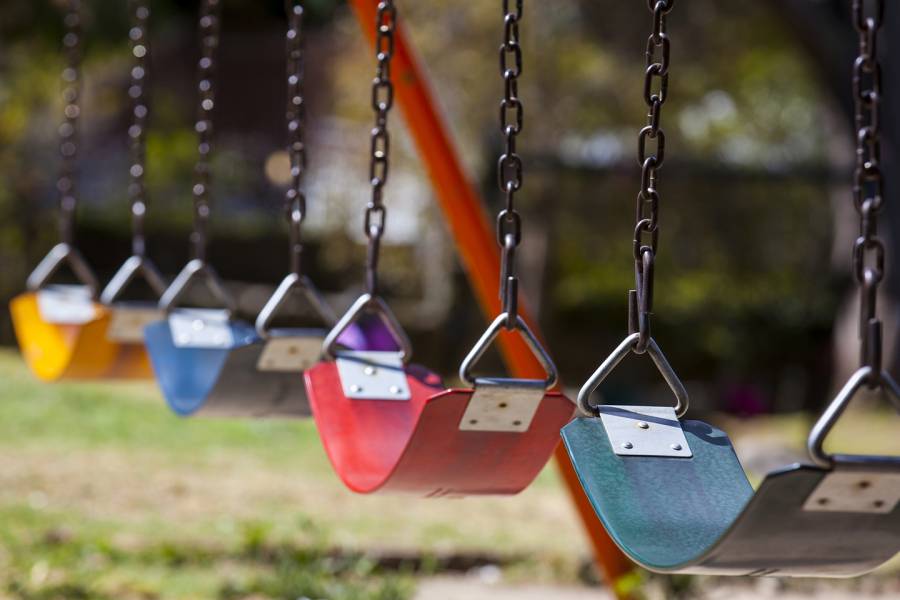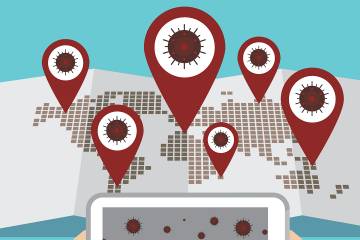With schools across the country closed amid efforts to slow the spread of the coronavirus, parents and kids are adjusting to new routines and doing what they can to make the best of their new normal.
What precautions should families follow to stay safe during the COVID-19 pandemic, and how we can ensure that staying safe does not mean staying sedentary? For answers, we turned to Keshia Pollack Porter, whose research focuses on strategies for ensuring safe environments for kids to promote physical activity and play.
Pollack Porter, a professor of health policy and management and associate dean for faculty development at the Johns Hopkins Bloomberg School of Public Health, spoke with Sarah LaFave, PhD student at the Johns Hopkins School of Nursing. Their conversation has been edited for length and clarity.
What does the current guidance on "social distancing" or "physical distancing" mean for families with children?
I really want to lift up what you said in terms of physical distancing. I think that's a much better term because while we need to be separate, we can still be social.
We do need to make sure our kids are staying six feet apart from other people, including when they're outside playing. There's evidence that the coronavirus can transmit through droplets on objects and surfaces so, for right now, we really don't want kids to touch each other or even to touch an object that another child has just touched, like a ball or playground equipment. Since it's pretty unrealistic to expect kids to stay six feet apart from each other while on a play date, kids shouldn't be playing with kids from outside of their households right now.
One of the challenges with this virus is that people can carry and transmit the virus but be asymptomatic, so even if you are spending time with a family who doesn't seem sick, you're at risk for helping the virus to spread. Parents and guardians should monitor their children when they're playing outside to make sure they're not in close proximity to other people.
It sounds like the bottom line is that we should be limiting our in-person interactions to the members of our households, but that doesn't mean that kids have to stay inside. What outdoor activities are safe for families right now?
We need to give kids opportunities to be outside and engage in free play because it's critical for their physical, mental, and emotional health. So we can embrace solo play—things like using a jump rope, using a hula hoop, riding a bike or scooter (with a helmet of course). Even if there's no green space near where you live, you can have fun outside with activities like using sidewalk chalk to draw or play hopscotch. We want kids to play, we want everyone to be active, we want you to have fun—just in a way that keeps you at least six feet away from other individuals. Kids should get at least 60 minutes of activity each day, not necessarily all at once; even 10-minute increments throughout the day can work.
For kids who don't live with other kids, this could end up being a pretty lonely time. Do you have any suggestions for how children can safely connect with their peers?
Absolutely, and I think this is where technology can be really helpful. Of course, as someone who studies physical activity and play, I'm not promoting sticking your kid in front of the television all day. There are lots of apps out there that can really help you and your kids to connect with people and be active. For example, my extended family has been connecting using an app called House Party, which is really cool. You can have a large group of people on the video call, and even play together on the app using built-in trivia games and other features.
Many adults are working full-time, helping kids keep up with remote schoolwork, providing care to older family members, dealing with financial stressors, and balancing other responsibilities. What advice do you have for adults who do not have the time and energy to develop creative activities for their families?
We are certainly living through an unusual time that's placing a lot of competing demands on people. One suggestion is to find ways to couple responsibilities. For example, involving kids in helping you to prepare a meal could be an opportunity for them to simultaneously learn about math or nutrition or to move their bodies a little bit. Or, if you have a conference call, maybe think about taking that call outside, and letting your kids play at the same time. I also think it's important to acknowledge that this may not be feasible for everyone and to remember that these circumstances are temporary.
Do you worry about this situation having long-term effects on kids' health and educational outcomes?
For me, what this pandemic has revealed is how significant the underlying inequities are in this country—something the broader society is paying more attention to. For example, there's so much conversation about distance learning during these stay-at-home orders. The fact is there are many kids in this country who don't have access to computers or internet. Some schools have the resources to engage kids in virtual learning all day long. Other schools are sending students packets of assignments and just aren't able to provide the structure that kids need. For a parent who has the time and is home and can be engaged, they may be able to mitigate that so the child doesn't fall behind, but what about parents who are essential employees and cannot work from home or can't because of other responsibilities?
It's also important that we think about the stress and anxiety that this disruption may cause for kids. One thing that can help with that is creating a daily schedule to try and create a little bit of normalcy for them even if they aren't getting up and going to school every day. Sure, it's fun to keep your kids in their pajamas for one day, but there's also real value in getting up, getting dressed, and getting into a schedule to maintain some semblance of normalcy.
What can community organizations or policymakers do to mitigate those potential negative effects on families?
I think there are a couple of key areas for focus. I'm a big proponent of paid sick leave and family leave to support parents. Also, Congress has passed a relief bill to support businesses and individuals, but one thing that was missing, that I hope will receive additional attention, is support for the education gaps. That means increasing resources for computers and internet for students, funding summer programs so that they can support learning for kids who may be falling behind right now, and also funding those programs so that kids can take part in them regardless of their family's ability to afford registration. We need these resources to bail out our education system as much as we may need them to bail out big industries like the airlines.
Posted in Health, Voices+Opinion
Tagged coronavirus, covid-19, social distancing











